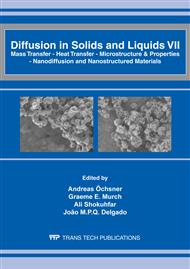p.682
p.690
p.696
p.702
p.708
p.713
p.719
p.725
p.731
Hydrogen Mobility in the Non-Martensitically Transforming Shape Memory Alloy Ni52Ti48
Abstract:
Hydrogen mobility has been studied at high temperature by absorption experiments in the Ni52Ti48 alloy, which does not transform martensitically but rather behaves like a so-called strain glass. The results obtained have been compared with those deduced from an anelastic relaxation occurring in this alloy below the strain-glass transition temperatures. An accurate analysis of the anelastic data has confirmed the conclusion that the relaxation is related to H rather than to the glass transition. Its relaxation time obeyed a Voogel-Fulcher type of temperature dependence. Combining absorption and anelastic results, the H diffusion coefficient in the B2 lattice structure of this alloy could be studied from 1200 K down to 170 K. The agreement between the absorption and mechanical spectroscopy data was satisfactory. The activation energy (0.33 eV) deduced from a Vogel-Fulcher representation of the H diffusion coefficient D was sensibly lower than earlier determinations (0.44-0.50 eV) from Arrhenius plots. The high temperature data of Ni52Ti48 alloy, compared with the ones available in the literature for other NiTi SMA in their B2 structure, show a substantial independence of D on the alloy composition.
Info:
Periodical:
Pages:
731-738
Citation:
Online since:
April 2012
Authors:
Price:
Сopyright:
© 2012 Trans Tech Publications Ltd. All Rights Reserved
Share:
Citation:


